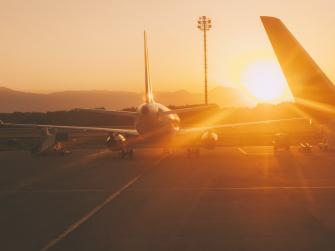5 ways climate change can make air travel worse
Climate change is contributing to hotter heat waves and more damaging storms. When it comes to air travel, these events can lead to delays, cancellations and bumpier skies.

Extreme heat can keep planes grounded
At hotter temperatures, planes need to go faster to take off. In extreme heat, planes might not have enough runway to get the speed they need to go airborne.
That heat can ground aircraft: A 119-degree day in 2017 led American Airlines to cancel more than 40 flights out of Phoenix.
Extreme heat calls for extreme action
Shifting jet streams can bring more turbulence
Scientists are studying climate change’s effects on jet streams – bands of air currents – and are noting stronger variations in wind speed, which can cause more severe turbulence.
Paul Williams, a noted atmospheric scientist at the University of Reading in Britain, calculated in a 2017 study that climate change could boost incidents of severe turbulence by 149 percent within decades.
Airport workers can endure health hazards
High temperatures on the tarmac can lead to heat stress and other illnesses associated with extreme working conditions.
During hot weather, concrete and asphalt turn into “heat islands” – spots that are hotter than the surrounding areas – making airport employees especially vulnerable.
Scientists are confident that continued warming threatens human health, potentially making working outdoors impossible in many regions.
Airports can suffer damage
Heat or flooding can make airports inoperable. When temperatures soar toward 100 degrees Fahrenheit, tarmacs can get soft and cause the wheels of planes to get stuck.
In addition to extreme heat, climate change – triggered by humans – is contributing to rising sea levels, which are leading to higher storm surges and more floods. In fact, from October 2015 to August 2016, the U.S. experienced five 1,000-year floods.
Meanwhile, many airports are located in flat, coastal areas or in vulnerable floodplains where extreme storms can inundate runways.
Why are floods hitting more places and people?
Weather can spike flight delays and cancellations
Weather causes about a third of flight delays, according to federal statistics. Delays overall cost industry and passengers billions a year.
One reason passengers take such a financial hit: Airlines consider weather an “act of God” out of their control. It’s up to them whether to offer refunds or compensation.
Scientists say climate change will likely bring more and increasingly intense storms, which could lead to more delays and cancellations in the coming years.
Are record-breaking hurricanes our new normal?
You can help reverse course
While more planes are coming into service, the global aviation industry, which accounts for 2 percent of global carbon dioxide emissions, is taking initial steps to reduce emissions.
What we need to do now is demand action – from leaders at every level – while urging companies to adopt sustainable business practices.
"Even the most seasoned frequent fliers may be alarmed at the prospect of a 149 percent increase in severe turbulence."
Paul Williams
Atmospheric scientist, University of Reading










